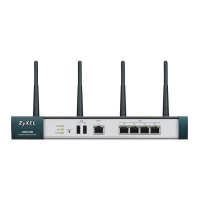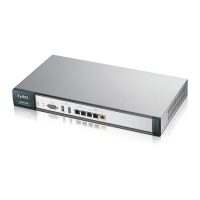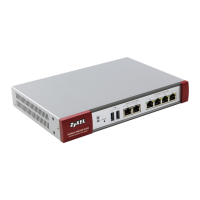Chapter 8 Route
UAG CLI Reference Guide
86
a route through the same gateway R1 (via gateway R2). The static routes are for you to tell the
UAG about the networks beyond the network connected to the UAG directly.
Figure 15 Example of Static Routing Topology
8.4 Static Route Commands
The following table describes the commands available for static route. You must use the
configure terminal command to enter the configuration mode before you can use these
commands. See Section Table 33 on page 81 for information on input values.
Table 36 Command Summary: Static Route
COMMAND DESCRIPTION
[no] ip route {w.x.y.z} {w.x.y.z} {interface|w.x.y.z}
<0..127>
Sets a static route. The no command deletes a static
route.
ip route replace {w.x.y.z} {w.x.y.z} {interface|w.x.y.z}
<0..127> with {w.x.y.z} {w.x.y.z} {interface|w.x.y.z}
<0..127>
Changes an existing route’s settings.
show ip route-settings Displays static route information. Use show ip route
to see learned route information. See Section 9.2.5
on page 92.
[no] ip route control-virtual-server-rules activate Gives static routes priority over NAT virtual server
rules (1-1 SNAT). It also automatically gives policy
routes priority over NAT virtual server rules. Use the
no command to give NAT virtual server rules priority
over static routes.
show ip route control-virtual-server-rules Displays whether or not static routes have priority
over NAT virtual server rules (1-1 SNAT).

